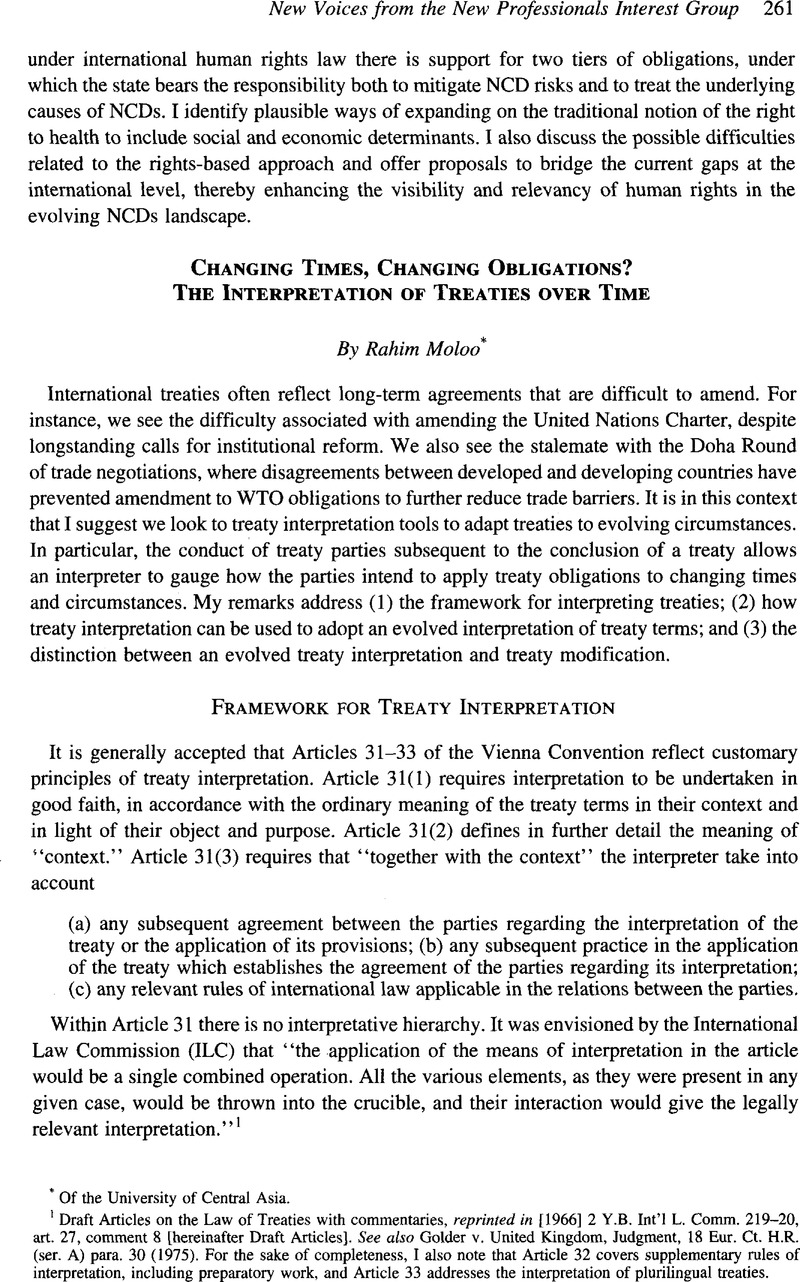Article contents
Changing Times, Changing Obligations? The Interpretation of Treaties over Time
Published online by Cambridge University Press: 28 February 2017
Abstract

- Type
- New Voices from the New Professionals Interest Group
- Information
- Copyright
- Copyright © American Society of International Law 2012
References
1 Draft Articles on the Law of Treaties with commentaries, reprinted in [1966] 2 Y.B. Int’l L. Comm. 219-20, art. 27, comment 8 [hereinafter Draft Articles]. See also Golder v. United Kingdom, Judgment, 18 Eur. Ct. H.R. (ser. A) para. 30 (1975). For the sake of completeness, I also note that Article 32 covers supplementary rules of interpretation, including preparatory work, and Article 33 addresses the interpretation of plurilingual treaties.
2 See, e.g., Canadian Cattlemen for Fair Trade v. United States, NAFTA/Uncitral Award on Jurisdiction, para. 188 (2008) (although the evidence presented was insufficient to come within Article 31(3)(a), it nonetheless came within Article 31(3)(b)).
3 Georg Nolte, Treaties Over Time in Particular: Subsequent Agreement and Practice, Int’l Law Comm’n, at 365, paras. 1-2, UN Doc. A/63/10 (2008), available at http://untreaty.un.org/ilc/reports/2008/english/annexA.pdf.
4 Id.
5 See, e.g., Mihaly Int’l Co. v. Sri Lanka, ICSID Case No. ARB/00/2, Award (Mar. 15, 2002) (finding that the definition of “investment” in the ICSID Convention was “left to be worked out in the subsequent practice of the States, Thereby preserving its integrity and flexibility and allowing for future progressive development of international law on the topic of investment.”).
6 Koskenniemi, Mariti, Fragmentation of International Law: Difficulties Arising from the Diversification and Expansion of International Law, Report of the Study Group of the Int’l Law Comm’n, UN Doc. A/CN.4/L.682 para. 478 (Apr. 13, 2006)Google Scholar.
7 Id; Case Concerning the Dispute Regarding Navigational and Related Rights (Costa Rica v. Nicar.), Judgment, 2009 I.C.J. 213 (July 13) (finding that an evolved interpretation of “commercial purpose” to include both goods and services was appropriate).
8 The principle of contemporaneity requires that a treaty be interpreted by reference to the circumstances prevailing when it was concluded.
9 See, e.g., NAFTA Free Trade Commission, Notes of Interpretation of Certain Chapter 11 Provisions (July 31, 2001)Google Scholar (clarifying the interpretation of certain terms in NAFTA).
10 See, e.g., Legal Consequences for States of the Continued Presence of South Africa in Namibia (South West Africa) Notwithstanding Security Council Resolution 276 (1970), Advisory Opinion, 1971 1. C.J. 16, para. 22 (June 21) (finding that the practice of the UN Security Council demonstrates that the requirement of a “concurring vote” from the permanent members is satisfied by an abstention); Case Concerning the Temple of Vihear, Preah (Cambodia v. Thai.), Judgment on the Merits, 1962 I.C.J. 6, 34 Google Scholar (June 15) (adopting an interpretation of the boundary line in a manner consistent with the parties’ conduct, but deviating from the relevant treaty clause).
11 Draft Articles, supra note 1, art. 38.
12 See Legal Status of Eastern Greenland (Den. v. Nor.), Judgment, 1933 PCIJ Series A/B, no. 53, para. 186 (Sept. 5); Ian Brownlie, Principles of Public International Law 153, 643-44 (7th ed. 2008).
- 4
- Cited by


